Yakazu is a logic puzzle in the same vein as Sudoku. The rules are simpler, but don’t let that fool you into thinking the puzzle is too! Harder level puzzles require some extended logical reasoning to complete.
In a hurry? Jump to: Rules / Tips / Worked Example / Video Tutorial / Download Free Puzzles / Books
Here’s an example of a small Yakazu puzzle:
The aim of the puzzle is to complete the grid such that every region of consecutive cells contains the numbers 1 to x, where x is the size of the region. So a run of cells that’s four cells wide must contain the numbers 1, 2, 3, and 4. Numbers can be in any order. Sounds simple, right?
Here’s what our small example puzzle looks like once it’s been solved:
Solving these puzzles requires a combination of elimination and logical reasoning. Here are some tips to help you get started, then we’ll work through an example puzzle.
We’re going to work through an example puzzle from beginning to end. Whilst every puzzle only has a single valid solution, there are lots of ways of reaching that solution. So please do bear in mind that this in not the way to solve this puzzle, just one possible way to solve it.

This is the puzzle we are going to solve. It’s a Level 1 puzzle, an easy 6x6 grid, which will provide an overview of the basic techniques for approaching Yakazu.
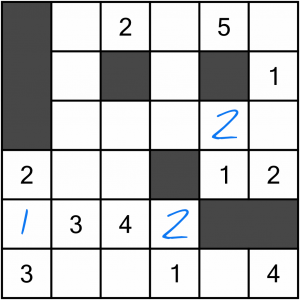
We’ll begin with the easiest of easy wins. There are a couple of two-cell regions we can fill in without a second thought (both of them taking a 2). We’ve also got a three-cell region missing just the 1. That cell also happens to complete a row.
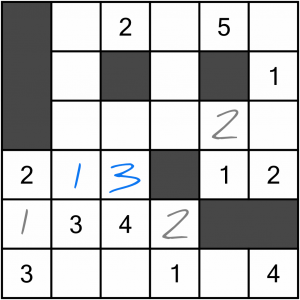
We can fill in this three-cell region. The middle cell cannot contain the 3 because it’s in a column that already has a 3. So the 3 has to go in the last cell, leaving the middle cell for the 1.

Column three is now easy to fill in. The 1 cannot go in the bottom cell because that’s in a row that already has one, so we put it in the top. That leaves the bottom cell for the 2.
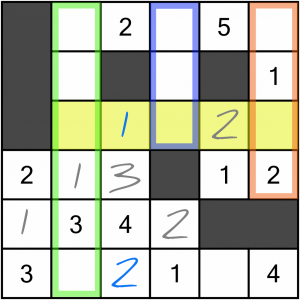
Let’s look at another technique. Consider the row highlighted in yellow; it is missing a 3, 4, and a 5. Ignoring any other way of working out what goes where (because we’re demonstrating a method!), we can focus on the 5. There’s only one place in the row it can go, and we can work it out by looking at the three intersecting columns, which happen to correspond to the three available empty cells.
Looking from right to left: the orange column is four cells high, so cannot take a 5. The blue column is three cells high, so also cannot possibly have a 5 in it. That leaves the green column, which is six cells high, and therefore can take the 5. Indeed it’s the only cell in that row which can do so…
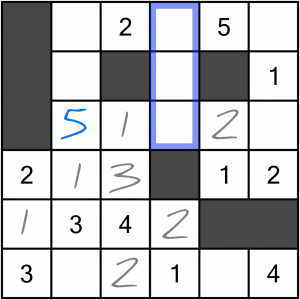
…and so we can write it in. Where next?
Well, the blue column should be easy enough to fill in, based on the two rows that cross it.
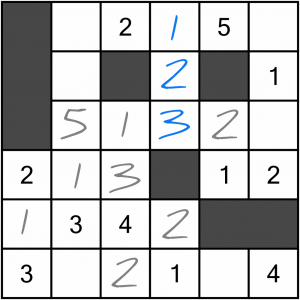
The bottom cell can only be a 3 (because it’s in a row that already has a 1 and a 2), and the 2 can only go in the middle cell, leaving the top cell as having to be the 1.
Now we can complete the third row down, because there’s only one free cell…
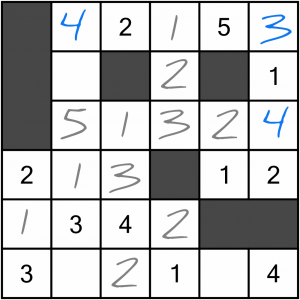
Putting a 4 in that last free cell means there’s only one place to put the 3 in the intersecting column, and that in turn leaves just the 4 for the top row. This can happen a lot in Yakazu – filling in one cell can lead to a chain-reaction, which is why it’s always worth checking for consequences when you complete a cell.
There are only three cells left to fill in, and they are simple to work out.
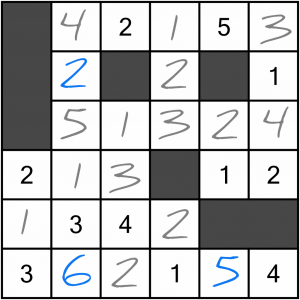
It doesn’t really matter whether you look at the six-cell row first or the six-cell column first, their intersections mean there’s only one way to complete them.
All done! Of course, that was the easiest level…the puzzles can get much tougher than this, requiring some deeper logical thinking. Ready to have a go yourself? Read on…
We’ve put together a taster of four puzzles for you, including the example above. You can download and print the PDF below. Solutions are included, but no cheating!
Finished the taster and want more great Yakazu puzzles? No problem! Get 120 carefully crafted puzzles set over seven levels in Puzzle Weekly Presents: Yakazu– it's great value!
We also include Yakazu in Puzzle Weekly from time to time. Puzzle Weekly is our free weekly puzzle magazine – find out more, and get your copy, here.